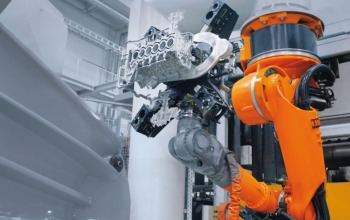
Energy-Efficient Industrial Robots: Optimizing Movement Patterns

One approach to this problems deals with movement patterns that require less acceleration energy, as was reported in the latest issue of the magazine “Pictures of the Future”.
Working with Volkswagen and Fraunhofer Gesellschaft as part of the Green Carbody Technologies (InnoCaT) innovation alliance, Siemens studied the motion sequences of manufacturing robots. The partners developed a simulation model that calculates the best trajectories for robots from the standpoint of energy efficiency.
Tests have shown that this approach can reduce energy consumption by up to half. Goal is to develop a software program that can be used to reprogram existing manufacturing robots to operate in a more energy-efficient manner, without making changes to the production process.
Manufacturing robots make an automotive factory fast and efficient, but they also consume large quantities of electricity. Particularly in body shell production, where numerous robots are deployed, they account for more than half of the total energy consumed. One approach to saving energy involves the control system.
Today's robots are extremely jerky in their movements. They move their arms along straight lines and brake abruptly at every change of direction before turning and accelerating again. This costs a great deal of drive energy and stresses the mechanics.
In the laboratory, the engineers analyzed a robot's energy consumption in different work steps. They wanted to know the extent to which changes of direction influence power consumption, and determine the parameters that result in the best movement patterns in terms of energy consumption.
This analysis yielded new algorithms for a simulation model that calculates optimal motion trajectories. Based on the lab tests, they found a savings potential of between 10 and 50 percent when the robot's arms move evenly along curved paths. Furthermore, the mechanical parts are placed under less stress, resulting in lower maintenance costs and fewer downtimes.
In the automotive industry it is extremely important that numerous manufacturing robots, which often hand over work to one another in a matter of seconds, operate together smoothly. Long tests under realistic conditions showed that optimized movement patterns can lower energy consumption by up to 50 percent, even with the same cycle times.
A software module that automatically programs a robot's power consumption for a given work process, while also accommodating the interplay with adjacent machines, is under test. Automation is important: It is the only economically feasible way to reprogram thousands of manufacturing robots in a single factory.
Siemens plans to integrate such a module into its Tecnomatix manufacturing software. This will allow existing robots to be easily and safely reprogrammed to consume less energy without requiring new investments in hardware.
http://www.siemens.com/innovationnews









![[Figure 1] Schematic of next-generation CNT-PANI composite fiber supercapacitor and comparison graph with recent results](https://www.innovations-report.com/wp-content/uploads/2025/05/KIST_leads_next-generation_energy_storage_technolo_1746783279-e1746784635527-362x245.jpg)


